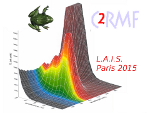The routine thermoluminescence (TL) dating technique is widely used to assess the construction chronology of buildings, and to highlight possible restorations and modern remakes. Unfortunately, dating bricks can be misleading, since the dated event is the last heating (>500°C, generally related to the brick production), that can significantly differ from that of the edification, also due to the practice of reuse. To avoid this problem a new technique, based on optically stimulated luminescence (OSL), has been developed. OSL surface dating uses the last exposure of a brick surface to light as the resetting event of the luminescence phenomenon. A necessary requirement is that sunshine reduces the OSL signal of the superficial layers to a level at or near zero after short exposure.
The first experiments on luminescence of surfaces were made on marble sculptures using the TL signal of quartz [Polikreti et al, 2002; Polikreti et al., 2003]. Later on, new attempts were tried on granites [Geirlich et al, 2005] and clasts [Sohbati et al., 2012] using OSL signals, which are better bleached than TL ones, giving a higher precision. OSL has been used to date the surface of medieval Uzbek bricks [Vieillevigne et al., 2006 ], with encouraging results. The Surface dating technique is anyway far from being a routine procedure, even if very satisfactory results have been recently obtained on rock art examples from Utah [Chapot et al., 2012].
A further application of surface dating to bricks was recently attempted in a renaissance wall. [Galli et al., 2014] It was possible to distinguish bricks contemporary to the edification from others surely reused.
The main requirement for the successful application of surface dating is the assessment of the bleaching effectiveness due to solar exposure. To evaluate the sunlight effects on the surface, small carrots of brick have been exposed to daylight for different periods ( from 60 s to 1 year). Measurements of the OSL/IRSL signals as a function of depth showed that after a few hours the signal from the surface was reduced to 20% of the archaeological one. The deeper layers were significantly bleached after one month of exposure. The depth profile of signals depends on the opacity of the material, on the daylight spectrum and on the exposure time. To describe the characteristic form of the OSL /IRSL resetting profile in a brick, an empirical model in proposed, in which a time-dependent exponential term has been added to the exponential function of depth used to describe the penetration of light [Sohbati et al., 2012].
References:
M.S. Chapot et al., Quat Geochronol 13 (2012).
A.Galli,M. Martini, F. Maspero, L. Panzeri, E. Sibilia, EPJ plus (2014)
S. Greilich, U.A. Glasmacher, G.A. Wagner, Archaeometry 47 (2005).
K. Polikreti, C.T. Michael, Y. Maniatis, Ancient TL 20 (2002).
K. Polikreti, C.T. Michael, Y. Maniatis, Radiat Meas 37 (2003).
R. Sohbati et al., J. Geophys Res-Sol 117 (2012).
E. Vieillevigne et al., Radiat Meas
- Poster

 PDF version
PDF version

